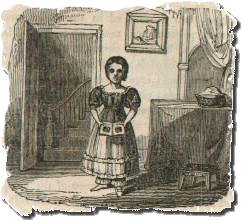NINETEENTH-CENTURY AMERICAN CHILDREN & WHAT THEY READ:
Some of Their Magazines
About 430 periodicals for children were founded in the U. S. before 1873. Learn more about them at “American Children’s Periodicals, 1789-1872,” an ever-growing descriptive bibliography.
Works on pre-1873 American children’s periodicals are listed or transcribed in a separate bibliography.
Puzzles appeared in most nineteenth-century American magazines for children. The Puzzle Drawer is a selection of puzzles printed in Woodworth’s Youth’s Cabinet and Robert Merry’s Museum. They range from the easy to one designed to be impossible. Try your wits! (And your patience!)
Not actually the first English children’s periodical (that honor tends to go to the irrepressible John Newbery’s The Lilliputian Magazine, published in a handful of issues from 1751-1752), The Juvenile Magazine appears to have been the first to look like a magazine. A monthly of 60 pages, the Juvenile Magazine included fiction and nonfiction, poetry, tiny plays, a column of interesting news items, and editorial advice to correspondents. It also had full-page illustrations: some issues had more than one. A serialized geography was illustrated with fold-out maps.
The Juvenile Magazine covered a wide variety of topics: geography, arithmetic, geology, social relationships. A series by “A Schoolboy” described life at a school for boys; “Familiar Letters on Various Subjects” explore arithmetic and female behavior. Occasional pieces in French allowed readers to practice that language. (For more information, see Janis Dawson. “Trade and Plumb-Cake in Lilliput: The Origins of Juvenile Consumerism and Early English Children’s Periodicals.” Children’s Literature in Education 29 [1998]: 175-198.)
But, why include it on a site about American periodicals for children?
Because it provided about a third of the material printed in the first American periodical for children. Founding the Children’s Magazine a year after the Juvenile Magazine, printers Hudson and Goodwin knew good material when they saw it. They couldn’t reproduce the illustrations, but they could reproduce the text.
Here you’ll find only pieces with echoes in the Children’s Magazine. I’ve also produced a table of contents for all twelve issues.
The “Editor’s Address to Her Young Readers” (January 1788) promises an educational magazine that could also act as a substitute parent.
Most of these serials were reprinted in the February 1789 issue of the American Children’s Magazine, missing when the magazine was reproduced as part of the American Periodicals Series. The issue was digitized as part of the American Antiquarian Society Historical Periodicals database.
Pieces by “The Female Adviser” (February & March 1788) appeared in the American Children’s Magazine, though strangely, the first piece—which introduces the series—wasn’t reprinted. The second piece is incomplete in the copy of the Children’s Magazine reproduced as part of the American Periodicals Series; it’s likely few, if any, changes were made.
“The Schoolboy” (April & June 1788) is one of several pieces purportedly from a boarding-school student. The April segment extolls the glories of the British system of government—not-so-oddly missing when the first American children’s magazine reprinted it in 1789.
The first American periodical for children, the Children’s Magazine established a few of the unofficial traditions—good and bad—which later periodicals would emulate—consciously or not.
Bad: like many later magazines, the Children’s Magazine lasted less than a year; among the factors felling it was the difficulty of sending a periodical through a postal system not really set up to distribute magazines. (See “Difficulties,” in Frank Luther Mott’s A History of American Magazines, 1741-1850, for more details.)
Good: the Children’s Magazine established the idea that a periodical could augment young readers’ experiences of the world; it included pieces on mathematics and morality, geography and gentility, offering an education in social values and academic subjects, just as later periodicals did.
Bad/good, fun/not: like other periodicals for children and adults, it republished pieces that had appeared elsewhere—an easy way to fill a magazine when there weren’t enough good pieces from contributors. About a third of the text in the Children’s Magazine was reprinted—with a few changes—from The Juvenile Magazine, published in London from January to December, 1788.
This turns out to be lucky for researchers: when the Children’s Magazine was reproduced as part of the widely available American Periodical Series, the February issue was unavailable. (It is reproduced as part of the American Antiquarian Society Historical Periodicals database.) But at least part of that issue can be reconstructed: the serials appearing in both periodicals. Changes were probably made—a paean to the British form of government was removed from one of the essays by “the Schoolboy”—but most were reprinted exactly.
Here you’ll find only the pieces echoing ones in The Juvenile Magazine. I’ve also produced a table of contents.
The “Preface” (January 1789) explains what the editor had in mind.
While the February 1789 issue wasn’t available to be reproduced as part of the American Periodicals Series, several parts of serials appeared in it; these sections were published in the February issue of The Juvenile Magazine.
Pieces by “The Female Adviser” (February & March 1788) appeared in the Children’s Magazine. Strangely, the first piece—which introduces the series—wasn’t reprinted in the February issue. The second piece is incomplete in the copy reproduced as part of the American Periodicals Series. It’s likely few, if any, changes were made when the piece appeared in 1789.
“The Schoolboy” (April 1789) is the last of three pieces from a boarding-school student; the editor removed a long section praising British government which anchored the version appearing in The Juvenile Magazine.
To “Nineteenth-Century American Children & What They Read”
Some of the children | Some of their books | Some of their magazines
Some works for adults, 1800-1872

